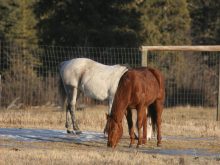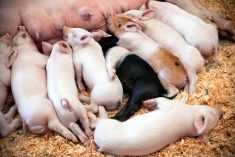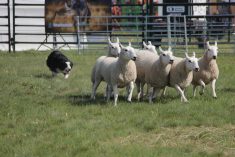TABER, Alta. — It is April 18 and 15-year-old Nigel Koomen is champing at the bit to start seeding.
His 40-year-old father, Casey, is willing to wait a few more days before they start planting beans, sugar beets and cereals on their four quarters of irrigated land north of Taber.
Casey Koomen farms with his wife Monique, their daughter Brittany and son Nigel.
They grow edible beans, sugar beets, pedigreed barley and durum in a four-year rotation. Living in the heart of potato-growing country, they rent or swap portions of land with farmers who need fresh fields for potato rotations.
Read Also

Why selenium is still an important factor in horse health
Selenium is an essential equine trace mineral that supports antioxidant defense, muscle integrity, immune function, metabolism and thyroid activity.
The Koomens grow beans and sugar beets under contracts that contain clauses stipulating the crops may only be grown on the same plot once in four years to curb diseases and insect pests.
Plans and contracts are in place for this year and Casey is already thinking about what he can do next year.
There is a further advantage to four-year rotations. As a pedigreed seed grower for a private distributor, Koomen’s chemical inputs are lower because there is less trouble with volunteer cereals the following year.
“Chances are very slim that any volunteers will come from the soil because it’s beans, beets, potatoes and then cereals,” said the elder Koomen.
While farming is always a challenge, this year may prove especially difficult.
Southern Alberta is a semi-arid region receiving less than 330 millimetres of precipitation per year. Warm, dry chinook winds during the winter dry up most of the snow. Summers are hot, windy and dry.
For the last two years, snowfall in the Rocky Mountains has been far below normal, so runoff and river flows needed for irrigation are substantially down.
Water rationing is a strong possibility this year, so farmers must decide if they want to find others willing to buy or trade water rights for their high-value crops.
Koomen has decided against buying someone else’s water allotment.
“I went back into more grain and chickpeas. Chickpeas need very little moisture. I’ll steal it away for the crops that need it more.”
Irrigation farming can yield high-value crops, but the investment is dear. The pivots that circle a 130-160 acre field may cost $100,000. Newer units require less water pressure and spread water more efficiently, but soaring natural gas and electricity costs reduce the crops’ profits. Koomen’s electricity bill last summer for pumping water was $5,000.
If energy prices continue to increase, even with promised provincial rebates, utility charges could double.
The Koomens think they should look for a value-added venture rather than buy more high-priced land.
“When you see what you get for your product and how much people get for the end product, it’s ridiculous. We’re going to try and tap into that somehow.”
Elsewhere in southern Alberta, water shortages will override other problems that may plague farmers this year.
A heavy, wet snowfall two weeks ago brought welcome moisture to many regions so farmers can be reasonably assured their crops will germinate.
Topsoil conditions are adequate from Taber west, but east of that region, farmers continue to scan the skies for rain.
Depleted subsoil moisture reserves mean farmers must depend on some decent rainfall this summer, said Alberta Agriculture crop specialist Carrie Rogers-Butterworth from Foremost.
Her area received enough precipitation recently to help them get started seeding.
“People are heading out with a renewed optimism,” she said.
Insects are another challenge although pest problems aren’t causing too much anxiety this year.
Many insects survived the mild winter but no one is expecting plagues of grasshoppers or cabbage seedpod weevils.
“Canola acres are down substantially so it could be a moot point,” she said.
The weevil was also beaten back by farmers and dry weather last year.
“Wide-scale insecticide use and the drought really clobbered the weevil,” said Rob Dunn of the Lethbridge agriculture office.
One insect pest that could be troublesome is the wheat stem sawfly. Growers are investigating resistant cereal varieties.
Reports last fall from Glacier County in Montana indicated high numbers of the pale western cutworm moth could be heading north.
Crop specialists are checking fields in the far south for eggs buried in loose soil. They should be able to tell farmers within three weeks if the pest has crossed the border.
“It is very difficult to detect them until you see your crops disappearing,” said Dunn.
If it does turn rainy, ascochyta blight might show up in legumes. Many people in the south are trying chickpeas this year and that disease is especially hard on some varieties.
Throughout the south, pastures are greening up thanks to the recent snowstorm, although the precipitation was not enough to refill dugouts.
Pumping projects to fill dugouts started March 19 rather than April 1, said water specialist Joe Harrington.
The province halved rental rates on pumps to help producers where there was little or no runoff this spring.
In addition, people may consider running small pipelines from farm wells to pastures. Alberta Agriculture provides a special plow to dig trenches to bury one-inch pipes carrying water to pastures.















